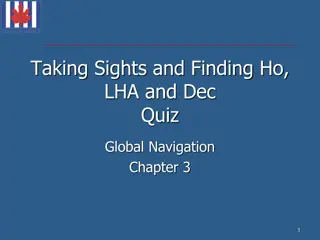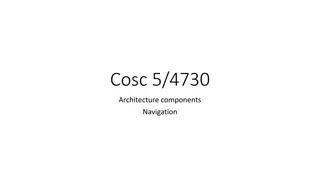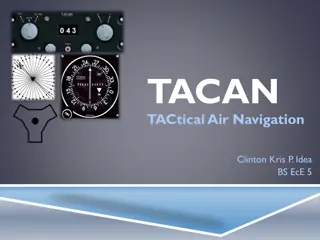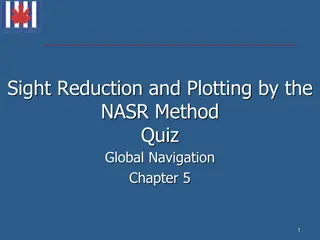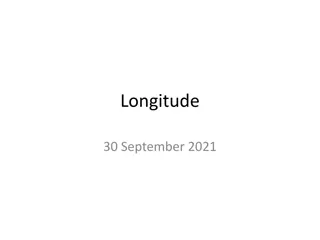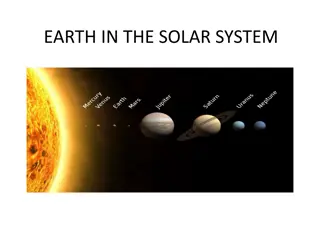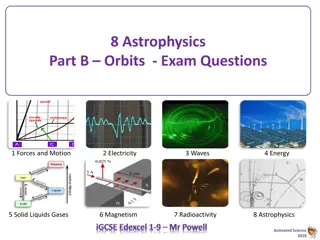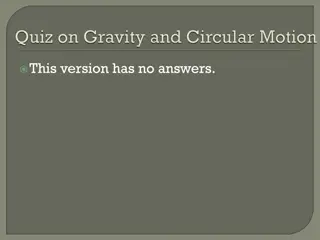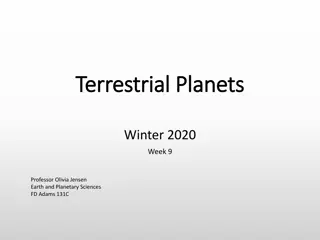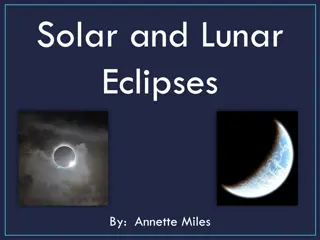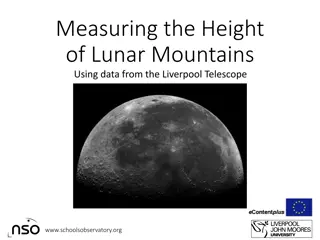Celestial Navigation Homework Solutions Chapter 3.1 - Taking Sights and Finding Ho, LHA, and Dec
Demonstrate and describe techniques for taking sights on moon, planets, and stars. Apply proper altitude corrections to determine Ho, compute LHA and Dec for each sextant observation, understand and apply celestial coordinates.
Download Presentation

Please find below an Image/Link to download the presentation.
The content on the website is provided AS IS for your information and personal use only. It may not be sold, licensed, or shared on other websites without obtaining consent from the author. Download presentation by click this link. If you encounter any issues during the download, it is possible that the publisher has removed the file from their server.
E N D
Presentation Transcript
Taking Sights and Finding Ho, LHA and Dec Global Navigation Homework Solutions Chapter 3 1
Objectives Demonstrate and describe techniques for taking sights on moon, planets & stars. Apply proper altitude corrections for these sights to deterimine Ho. Apply proper corrections for low altitude sights on any celestial body. Understand & apply new concepts of celestial coordinates. Compute LHA and Dec for each sextant observation. 2
Question 1 In the daily pages, the v value for the planets: a) is always positive. b) is positive except for Venus, which can be either positive or negative. c) depends on the declination of the body. d) is applied East or West to GHA. Ref: 83 3
Question 2 In the daily pages, the d value for the planets is: a) always positive. b) positive except for Venus, which is negative. c) positive or negative depending on the trend of the declination tabulated in the daily pages. d) positive or negative depending on whether declination is North or South. Ref.: 84 4
Question 3 The value of d tabulated in the daily pages is: a) the declination increment and always positive. b) the average amount by which the declination of a body changes in one hour. c) the variable rate of change in GHA during one hour. d) not applied to the sun or moon. Ref.: 84 5
Question 4 The declination of a body at 1423 UT is 20 16 N, and at 1523 UT is 20 29,4 N. The d value for this body is: a) between 0,0 and 0,1 . b) between 0,1 and 1,0 . c) between 1,0 and 5,0 . d) greater than 5,0 . Ref.: 84 6
Question 5 The body in the previous question is probably: a) the sun. b) the moon. c) Saturn. d) Achernar. Ref.: 84 7
Question 6 The v correction is: a) found in the daily pages. b) the amount by which the hourly change in GHA differs from the average rate of change for the body. c) the amount by which declination changes in one hour. d) the amount by which GHA changes in one hour. Ref.: 82 8
Question 7 Which of the following magnitudes is the brightest? a) 2,3 b) 1,5 c) -1,7 d) -2,0 Ref.: 73 9
Question 8 Which of the following could be a reasonable value of GHA increment for any celestial body in approximately one- half hour? a) 3 26,7 b) 7 25,2 c) 14 54,2 d) 29 58,7 Ref.: 81 10
Question 9 The sign of the v correction for the moon: a) is always positive. b) is always negative. c) can be positive or negative depending on the direction of change in successive hourly values. d) is positive when the declination of the moon is North. Ref.: 83 11
Question 10 Moon UL;06-20-09 UT; 28 March; Lo 070 14,7 W Moon UL; 06-20-09 UT; 28 March; Lo 070 14,7 W Moon LL;13-17-14 UT;30 March;Lo 165 51,1 E Mars; 14-04-23 UT; 28 March; Lo 009 21,8 W Venus; 07-27-27; 30 March; Lo 130 36,1 E Schedar; 02-27-09; 23 August; Lo 079 41,5 E Rigel; 23-11-34; 24 August; Lo 074 59,2 W For the following problems, use the Excerpts from the Nautical Almanac, Appendix B and the Increments and Corrections tables from any Almanac. Find GHA, LHA and the declination of each of these bodies. Venus; 07-27-27; 30 March; Lo 130 36,1 E Lo -070 14,7 W LHA 120 49,8 -360 LHA 72 43,8 LHA 17 47,5 LHA 78 00,5 GHA GHA 14-00 GHA 07-00 SHA GHA GHA 333 51,1 Dec +1 05,8 d (+)0,3 +6 51,8 d (+)0,8 1 42,3 27 19,6 N 25 38,4 N 22 10,4 N 22 20,6 N 56 33,6 N 8 11,5 S Moon LL; 13-17-14 UT; 30 March; Lo 165 51,1 E GHA 06- 00 186 12,5 Dec 20- 09 +4 48,5 d (+)1,8 v 10,1 corr. v +3,5 602 46,0 -360 Total GHA 242 46,0 Total Dec 8 11,5 S Lo -074 59,2 W LHA 167 46,8 SHA 13- 00 04-23 27-27 02-00 23-00 318 33,2 11-34 262 43,1 Dec +4 06,7 +2,9 +0,1 -0,0 +6 48,4 +2 54,0 240 19,6 Dec 349 48,3 Dec 281 18,8 Dec d (-)5,6 corr. d corr. d corr. d 17-14 27-09 v 10,1 corr. v v 0,8 corr. v v -0,0 corr. v + 0,0 -1,6 + 0,6 + 0,4 Mars; 14-04-23 UT; 28 March; Lo 009 21,8 W corr. d Total GHA Total GHA Lo Lo Lo 266 52,7 Total Dec25 36,8 N 334 57,0 Total Dec 22 10,4 N -009 21,8 W +130 36,1 E +079 41,5 E Total GHA Total GHA 247 11,4 Total Dec 22 21,0 N 358 19,0 Total Dec 56 33,6 N Total GHA 191 04,5 Total D. 27 20,2 N Lo +165 51,1 E 432 43,6 LHA 325 35,2 377 47,5 438 00,5 Schedar; 02-27-09; 23 August; Lo 079 41,5 E -360 -360 Rigel; 23-11-34; 24 August; Lo 074 59,2 W 12
Question 11 On 1 March your DR position is L29 07.4'N, Lo 034 15,8'W. At 18-31-04 you obtain a sight on Sirius with an Hs of 36 56,5'. A few minutes later at 18- 36-15 you take a sight on Mars with an Hs of 60 32,0'. Both sights are taken on a natural horizon. Watch error is 00-0 sec; index correction is 0,0', height of eye 15 ft. Complete the sections of a USPS SR96 form needed to determine LHA, Dec, and Ho, and complete the Time Diagrams for each sight. Use Appendix B, Excerpts from the Nautical Almanac and the Increments and Corrections tables from any Almanac. Body LHA 332 08,9' 16 43,4'S 36 51,4 029 59,9' 17 58,7'N 60 27,7' Dec Ho 11a. Sirius 11b. Mars 13
Question 12 Columnar solution: Sight No. WT 10 11 12 13 14 Sight WT WT (decimals) Hs Hs (decimals) 40,30167 40,28667 40,26333 40,24333 40,23 201,325 40,265 Hs 40 18.1 40 17.2 40 15.8 40 14.6 40 13.8 Find the average WT and Hs of the following data using one of the two methods described in this chapter. 13 18-59-43 18,99528 14 19-01-01 19,01694 Sum 94,87056 Average 18-58-27 18,97411 Sum: 90 291 74 Avg: 18 290/5 134/5 Avg: 18 58 27 10 11 12 18-56-02 18-57-10 18-58-18 18 18 18 19 18 -01 61 -01 18,93389 18,95278 18,97167 -57 -58 -59 40 18,1 40 17,2 40 15,8 40 14,6 40 13,8 18 -56 -02 -10 -18 -43 40 15,9 14
Question 13 Compute the latitude by the Polaris Tables method described in this chapter (and in the Nautical Almanac)? Date 16 September WT 18-03-52 WE 0-27 feet HE 56 feet Hs 42 49,1 IC -1,2 DR L 43 06,6 N DR Lo 069 22,8 W 15
Taking Sights and Finding Ho, LHA and Dec End of Chapter 3 16




